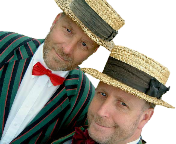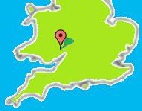












Open daily from 10:00, lovely and warm! Last entry at 3 pm




A.B. Farn Festival 2011-2014
Wye Valley Butterfly Zoo is commemorating the centenary of the work of Albert Brydges Farn F.E.S., entomologist, ornithologist, and country sportsman in the Symonds Yat area. A series of events is planned, starting with the publication of our Spotters’ Guide and Nature Notes. Others are to be announced.
A.B. Farn retired to Herefordshire in 1906 in the vain hope of finding a surviving colony of Mazarine Blue butterflies, which had been collected to extinction. Suddenly, after hearing that the European Map butterfly had been seen near Ross-on-Wye in 1912, he moved to Doward Cottage, together with his magnificent collection of british lepidoptera, the finest of his time. The cottage backed onto a hill called The Doward, which is looped by the Wye Gorge and had been known to collectors of butterflies for over sixty years. Here “A.B.F.” studied Herefordshire’s signature butterfly, the Comma, and collected European Maps, Purple Emperors and Wood Whites. He fished for salmon, reared Silver-washed Fritillaries, stuffed bats and mice, and made his superb collections available to invited scientists.
A.B.F. had spent his personal fortune at collectors’ auctions. He had published his expert knowledge as a druggist for protecting collections from decay and pests. He had organised insect collectors’ fairs in London, creating a trade which ensured that scientists could obtain rare specimens for research. He had thus played a large part in turning an obsession of country parsons and doctors into a relatively bloodless country sport which was accessible to all: The family at Little Hadnock Farm, just across the River Wye from The Doward, collected butterflies; a forestry worker who lived on the other side of The Doward used every room of his cottage to breed rare varieties for collectors who lodged there; and many a victorian schoolboy kept a jar of cyanide for killing butterflies!
But high values of rare specimens had long led to temptation, for example in 1850 the Editor of the Monmouth newspaper had claimed that he had caught Large Copper butterflies on The Doward, a long way from the species’ headquarters in East Anglia. He had probably been a victim of “the planting fraud”: The scam was to arrange for a respected collector to catch a butterfly which had been secretly released in a location where it was unknown. Publicity of the capture gave false provenance to specimens which could be sold by mail order, and news of the find would attract collectors to the area, bringing profit to the tourist trade. In the wake of Darwin’s publication of the theory of evolution, the easy study of insect variety created huge demand.
In 1911 a species from mainland Europe, the European Map, was released in the Forest of Dean near Ross-on-Wye, and later captured near Symonds Yat and on The Doward. Farn had hunted alien insects in London docks. He knew more about breeding british insects, their parasites and host plants than anyone else - what we now call ecology. He knew that pollutants from industrialization skewed natural selection. As a result of this life-long experience, A.B.F. now believed that no alien fauna or flora should be ever be brought to the British Isles.
He moved immediately to destroy the colony. It took him only three years even though he was crippled with a bent leg, was seventy years old, in failing health, and the hill is steep and rugged. He acted in complete secrecy, while entomologists speculated about the identity of this “vandal”.
We will never know whom he suspected of releasing the European Map to breed on the nettles of The Doward, but somehow A.B.F. destroyed the colony and put a stop to the “planting” of these aliens. He was famous for berating fraudsters at full volume and at great length, and could never forgive any slight, whether real or imagined. Guilty or innocent, perhaps that is why the forestry worker who had raised rare butterflies at his home left for the West Country within months.
In 1919 a little girl found a Purple Emperor, waterlogged in a bramble bush outside Doward Cottage, and took it to the old collector. This bedraggled, dying specimen was the last that he would see, and was the very last to be seen at Ganarew. In his old age A.B.F.’s eccentricity and pedantic obsessions were caricatured, even by his friends. His death went unreported, and it was left to his old friend, the great F.W. Frohawk, to tell the world who had destroyed the European Map in Symonds Yat. The news was so shocking that some entomologists refused to believe that their hero could have done such a thing, and doubted that he could have achieved the extermination at such advanced age.
We would be ignorant of extinctions and of the pressure that we exert on wildlife if it had not been for A.B.F. and collectors like him. His contributions to science were to advance curation of insect collections, to popularise collecting and trade in specimens, and to prove variation in every species. Although his anticipated extinction of the Silk Moth didn’t happen, he failed in his search for a silk-producer to rival the silkworm. His discovery of Industrial Melanism - the proof of natural selection - was wrongly credited to J.W. Tutt some 18 years after A.B.F. wrote to Charles Darwin about it. His great collection was dispersed by auction after his death.
His unintended legacy is his contribution to modern ethics, but it has taken decades to mature. Nearly twenty years after his death, Field Naturalists still hired excursion trains to explore The Doward, and a boy in Symonds Yat was seen searching for a rotten rabbit to lure Purple Emperors in the hope of a handsome reward. But Albert Brydges Farn had proved that butterfly collecting, the hobby that he had himself popularised, could bring about extinction. No longer required by science, collecting became the object of derision and the hobby died out in Britain. Today it is illegal to liberate an alien species in Britain without a licence, or to trade or even handle endangered species.
But the history of entomology in the Upper Wye Gorge presents new dilemmas for conservation: It has an unusually wide variety of species, but were any others introduced by The Planting Fraud to attract rich tourists? Six of the species Farn knew here are locally or even nationally extinct, but is it just the way we have changed their habitat, or did some only become extinct because butterfly collectors no longer visited by the trainload, so there was nobody to defraud by liberating them? Should extinct species be reintroduced? And as global warming pushes species onto higher ground and ever northwards, should the British Isles be used as an Ark to save alien species that are endangered across the English Channel?
Wye Valley Butterfly Zoo is located in the shadow of The Doward, and has a continuing program of research into the life of Albert Brydges Farn, the contemporary occurrence of butterfly species that the great collector knew there, and the feasibility of reintroduction of the extinct species.
Research: Lindsay Heyes
Copyright © Wye Valley Butterfly Zoo, Symonds Yat, 2011-2012